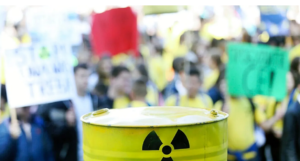
First Deputy Minister of Foreign Affairs of Ukraine Serhiy Kyslytsya discussed ways to strengthen trade and economic cooperation between the two countries with Deputy Minister of Foreign Affairs of China Liu Bin in Beijing.
“In Beijing, First Deputy Minister of Foreign Affairs Serhiy Kyslytsya held Ukrainian-Chinese political consultations with Assistant (Deputy) Minister of Foreign Affairs of the People’s Republic of China Liu Bin,” according to a statement from the press service of the Ministry of Foreign Affairs.
According to the report, the parties discussed topical issues on the bilateral agenda, outlined plans for further contacts at the highest and high levels, discussed ways to strengthen trade and economic cooperation, and issues of interaction within international organizations.
The interlocutors confirmed that mutual respect for sovereignty and territorial integrity is the foundation of Ukrainian-Chinese relations.
“There was an in-depth exchange of views on the current situation related to the ongoing armed aggression of the Russian Federation against Ukraine, as well as international efforts to achieve sustainable and lasting peace,” the statement said.
As part of his working visit to Beijing, Kislitsya also met with representatives of Chinese expert and analytical circles, as well as the diplomatic corps of partner countries.

Centrenergo PJSC plans to end 2025 with a net profit of approximately UAH 4.5 billion after many years of losses, according to Andriy Gota, chairman of the company’s supervisory board.
“This year, Centrenergo should end with financial results that have not been achieved for decades. This is approximately UAH 4.5 billion in net profit. The company’s previous managers accumulated losses of UAH 16 billion over 20 years,” Gota said in an interview with the Energorforma internet portal.
He noted that the company has not reported losses since July 2024.
“The company also repaid almost UAH 2.5 billion in debts from previous periods, including to state-owned mines and Naftogaz, and stopped accumulating them,” said the head of the NR.
According to him, at the same time, the debt of NEC Ukrenergo to the company in the balancing market amounts to UAH 2.2 billion, having doubled compared to last year’s figure.
As reported, Centrenergo is the operator of the Trypilska TPP in the Kyiv region and the Zmiivska TPP in the Kharkiv region. The company’s Vuhlehirsk TPP in Donetsk region has been occupied since mid-summer 2022. The first massive strike on the Trypilska TPP took place in April 2024, and on the Zmiivska TPP in December 2022.
The current supervisory board was appointed in August 2023. At that time, it appointed Andriy Churkin, former director of PJSC “Kharkivenergosbyt,” as chairman of the board of Centrenergo, who was replaced in July 2024 by the company’s technical director, Yevhen Harkavyi.
Applications for the competition to select candidates for the supervisory board of Centrenergo are being accepted until December 23: three independent members and two state representatives. In an interview, Gota said that he would not apply to participate in this competition and would leave the company.

Following a meeting with Portuguese Prime Minister Luís Montenegro, Ukrainian Prime Minister Yulia Svyrydenko announced the country’s first contribution to the Energy Support Fund for Ukraine in the amount of EUR600,000.
“During the meeting, the Prime Minister of Portugal announced the first contribution to the Energy Support Fund for Ukraine in the amount of EUR600,000. We highly appreciate this step by our partners,” the Telegram message said.
The parties also discussed Portugal’s defense support for Ukraine, in particular through the PURL and SAFE mechanisms, as well as the Build in Ukraine and Build with Ukraine initiatives, which have significant potential for developing cooperation, particularly in the field of joint drone production.
In the context of preparations for the next Conference on the Reconstruction of Ukraine, the parties agreed to work on the conclusion of an intergovernmental agreement (G2G) to promote the involvement of Portuguese business and investment in the Ukrainian market.
“I also emphasized to the Prime Minister that Ukraine is grateful to the leaders of the European Union for their decision to provide Ukraine with EUR 90 billion in funding over two years — this is incredibly important assistance for Ukraine,” the Prime Minister stressed.

Sweden has announced that it will provide Ukraine with $200 million in direct budget support in 2026 to help meet the daily needs of citizens in the midst of the war, Ukrainian Foreign Minister Andriy Sybiga said.
“This funding will meet the daily needs of people in the midst of war, including critical public services, energy supplies, healthcare, schools, pensions, and other payments. We are deeply grateful to Sweden for its determination, support, and unwavering solidarity,” Sibiga said in a post on social media on Saturday.
According to him, Sweden has shown leadership from the very beginning: in August, it became the first country to provide Ukraine with $75 million in direct budget support, and now it is reinforcing that leadership with an additional contribution.

According to SIPRI, the top ten companies (in terms of revenue from arms sales and military services) in 2024 are as follows:
1. Lockheed Martin (USA) – $64.65 billion (+3.2% compared to 2023)
2. RTX Corporation (USA) – $43.6 billion (+4.1%)
3. Northrop Grumman (USA) – $37.85 billion (+3.3%)
4. BAE Systems (UK) – $33.79 billion (+6.9%)
5. General Dynamics (USA) – $33.63 billion (+8.1%)
6. Boeing (USA) – $30.55 billion (-4.6%)
7. Rostec (Russia) – $27.12 billion (+26%)
8. AVIC (China) – $20.32 billion (–1.3%)
9. CETC (China) – $18.92 billion (–10%)
10. L3Harris Technologies (USA) – $16.21 billion (+6.6%)
Together, these ten corporations account for the lion’s share of global defense industry revenue and set the technological and manufacturing bar for other players.
SIPRI (Stockholm International Peace Research Institute) is an independent international research institute working in the field of conflict, armaments, arms control, and disarmament. The institute was established in 1966 by a decision of the Swedish Parliament and operates as an independent foundation with headquarters in Stockholm (Solna).
SIPRI publishes data, analysis, and recommendations based on open sources, which are widely used by governments, international organizations, researchers, and the media. The organizational structure includes
SIPRI’s funding includes an annual grant from the Swedish government and funds from other organizations; the institute emphasizes that it does not accept funding that could influence the independence of its research and discloses its sources of support.
Among SIPRI’s most cited products are the SIPRI Yearbook and open databases, including those on international transfers of major conventional weapons (since 1950) and on military expenditures of countries worldwide (time series since 1949, updated annually).
Source: https://expertsclub.eu/top-10-svitovyh-vyrobnykiv-ozbroyen-u-2024-roczi-za-versiyeyu-sipri/

According to Serbian Economist, the Croatian parliament has approved a law paving the way for the construction of a radioactive waste management center at the Čerkezovac site on Trgovska Gora Mountain in Sisak-Moslavina County, less than a kilometer from the border with Bosnia and Herzegovina.
According to the law, the Čerkezovac site will become the central facility for storing low- and medium-level waste from the Slovenian-Croatian Krško Nuclear Power Plant, as well as so-called “institutional” radioactive waste from Croatian hospitals and industry. The site is located approximately 800 m in a straight line from the BiH border and about 1 km from the water intake of the Novi Grad community, which supplies drinking water to about 15,000 people.
The adopted act creates a regulatory framework for the design and construction of the facility and establishes Čerkizovac as a priority location for a waste management center. Geological surveys, seismic risk assessments, and measurements of the “zero” radiation background have already been carried out at the site, as reported by the Croatian side in documents sent to international organizations.
A surface storage facility is planned to operate until the 2090s, after which the waste will be transferred to a deep geological repository.
Strong reaction from Bosnia and Herzegovina
Zagreb’s decision has been strongly criticized by politicians and environmental activists in Bosnia and Herzegovina. The country’s authorities had previously set up interdepartmental expert and legal groups to follow up on the issue at international forums and insist that the facility poses a risk to the Una River, border communities, and drinking water supplies.
Political parties and authorities in BiH consider the law to be a violation of the principles of good neighborliness and are demanding that Croatia reconsider its decision or seek an alternative site, citing, among other things, the Espoo Convention on Environmental Impact Assessment in a Transboundary Context.
The Croatian side, in turn, states that the environmental impact assessment procedure will include the participation of the public and the competent authorities of BiH.
https://t.me/relocationrs/1977